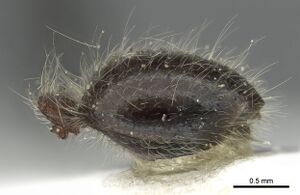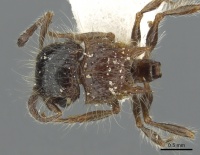Meranoplus birmanus
| Meranoplus birmanus | |
|---|---|

| |
| Scientific classification | |
| Kingdom: | Animalia |
| Phylum: | Arthropoda |
| Class: | Insecta |
| Order: | Hymenoptera |
| Family: | Formicidae |
| Subfamily: | Myrmicinae |
| Tribe: | Crematogastrini |
| Genus: | Meranoplus |
| Species: | M. birmanus |
| Binomial name | |
| Meranoplus birmanus Schödl, 1999 | |
Nothing is known about the biology of Meranoplus birmanus.
Identification
Schödl (1999) - Meranoplus birmanus is externally very similar to the sympatrically occuring Meranoplus bicolor, which doubtless is a close relative (it is not known whether the two species live syntopic). and not covered with a distinct rugo-reticulum, which in particular is apparent on the promesonotal shield in Meranoplus bicolor; by the petiole being distinctly shorter in Meranoplus birmanus (0.31 - 0.39; PTI 73 - 84), whereas in Meranoplus bicolor the length of the petiole is almost equal to its height (0.39 - 0.44; PTI 93 - 100); furthermore the promesonotal shield is slightly broader in Meranoplus birmanus (PW 088 - 0.98; PMI 126 - 134) than in Meranoplus bicolor (PW 0.8 - 0.9; PMI 120 - 130).
Keys including this Species
Distribution
Latitudinal Distribution Pattern
Latitudinal Range: 23.53472222° to 23.53472222°.
| North Temperate |
North Subtropical |
Tropical | South Subtropical |
South Temperate |
- Source: AntMaps
Distribution based on Regional Taxon Lists
Oriental Region: Myanmar (type locality).
Distribution based on AntMaps
Distribution based on AntWeb specimens
Check data from AntWeb
Countries Occupied
| Number of countries occupied by this species based on AntWiki Regional Taxon Lists. In general, fewer countries occupied indicates a narrower range, while more countries indicates a more widespread species. |

|
Estimated Abundance
| Relative abundance based on number of AntMaps records per species (this species within the purple bar). Fewer records (to the left) indicates a less abundant/encountered species while more records (to the right) indicates more abundant/encountered species. |

|
Biology
Castes
Images from AntWeb
 
| |
| Paratype of Meranoplus birmanus. Worker. Specimen code casent0902034. Photographer Ryan Perry, uploaded by California Academy of Sciences. | Owned by NHMUK, London, UK. |
Nomenclature
The following information is derived from Barry Bolton's Online Catalogue of the Ants of the World.
- birmanus. Meranoplus birmanus Schödl, 1999: 62, figs. 1-3, 7, 9, 11 (w.) MYANMAR.
- Type-material: holotype worker, 27 paratype workers.
- Type-locality: holotype Myanmar: Sagaing Division, Chatthin Wildlife Sanctuary, 23°32’05’’N, 95°38’53’’E, ca 200 m., 5-17.x.1998 (Schillhammer); paratypes with same data.
- Type-depositories: NHMW (holotype); BMNH, MCZC, MHNG, NHMB, NHMW, USNM (paratypes).
- Distribution: Myanmar.
Unless otherwise noted the text for the remainder of this section is reported from the publication that includes the original description.
Description
Worker
Holotype: TL: 4.2, HL: 0.95, HW: 0.9, CI: 0.71, SL: 0.71, SI: 79, PML: 0.73, PW: 0.93, PMI: 127, AL: 1.0, PTL: 0.35, PTH: 0.44, PT!: 80. Paratype workers: TL: 4.14 ± 0.17 (3.8 - 4.4), HL: 0.94 ± 0.029 (0.88 - 0.96), HW: 0.88 ± 0.023 (0.84 - 0.90), CI: 94 ± 1 (91 - 95), SL: 0.71 ± 0.019 (0.68 - 0.73), SI: 80 ± 1 (78 ~ 82), PML: 0.72 ± 0.027 (0.69 - 0.78), PW: 0.93 ± 0.031 (0.88 - 0.98), PMI: 130 ± 3.17 (126 - 134), AL: 0.99 ± 0.008 (0.98 - 1.00), PTL: 0.35 ± 0.024 (0.31 - 0.39), PTH: 0.45 ± 0.023 (0.41 - 0.48), PTI: 77 ± 4 (73 - 84) (12 measured).
Mandibles striate, armed with four teeth. Mid-portion of clypeus rugose, particularly lateral sides; anterior clypeal margin concave, lateral comers produced into stout to acute angles. Frontal triangle apparent as a curved shiny furrow between posterior clypeal margin and anterior frontal margin. Head above the antennal scrobes posteriorly parallel sided, lateral margins slightly indented above level of the eyes; from about middle evenly but distinctly arcuately narrowed towards clypeus; anterior lateral margins somewhat lamellate and translucent. Ventral part of head (below the antennal scrobes) of similar shape, slightly broader than dorsal part of head, thus feebly protruding in dorsal view. Antennal scrobes shiny and glabrous throughout, posteriorly with few transverse rugae above eyes. Genae costate to rugose, with occasional cross-meshes. Compound eyes situated distinctly behind middle of lateral sides of head. Maximum diameter of eye 0.21 - 0.25, with 12-13 ommatidia in the longest row.
Promesonotum wider than long. Lateral margins of the promesonotal shield overhanging sides of alitrunk; propodeum distinctly overhung by lamellate hind margin of mesonotum. Anterior comers of pro no tum rectangular, produced into acute teeth; lateral margins of pronotum sinuate, narrowed posteriorly and distinctly indented at about level of (invisible) promesonotal suture, the constriction surrounded by a translucent, lamellate area. Lateral mesonotal margins evenly narrowed and produced into stout posteriorly directed projections; anteriorly the mesonotal margins lamellate; posterior mesonotal margin with a broad translucent lamella between lateral projections. Declivity of propodeum anteriorly with few longitudinal rugae, basally with a very indistinct shagreen; lateral propodeal spines thin and acuminate, situated at about middle of propodeal length. The suture between dorsal alitrunk and propodeum distinctly apparent on the declivity beneath posterior mesonotal margin, when viewed from behind.
Petiole tapered from base to crest, markedly higher than long, both anterior and posterior faces glabrous and shiny, meeting in an acute angle. Postpetiole nodiform, in lateral view the posterior outline somewhat angulate, and strongly reticulate rugulose. Gaster carinulate at extreme base, the remainder shiny and covered with a faint, partly incomplete shagreen with occasional striolae.
Dorsum of head anteriorly carinulate, that of promesonotum rugose in particular posteriorly, with only few meshes; surfaces between rugae and carinulae shiny or with faint microsculpture; distance between costulae on head ca 35 - 70 µm, width of meshes on promesonotum ca 50 - 100 µm. Pilosity consisting of whitish short decumbent hairs (ca. 150 - 200 µm long), and longer, out-standing hairs (ca. 400 - 550 µm long). All studied individuals are bicoloured with the head and gaster piceous and the alitrunk, petiole, postpetiole, and appendages ferrugineous to dark brown.
Type Material
Surrounding of San Myaung Camp (l2°32'05.6"N 95°38' 53.7"E); ca. 200 m a.s.l.; degraded secondary Dipterocarpus tuberculatus forest with sandy soil and only occasional leaf litter; Chatthin Wildlife Sanctuary, Kanbalu Township, Sagaing Division, Myanmar. Holotype worker, Myanmar: Sagaing Division Chatthin Wildlife Sanctuary 23°32'05"N 95°38'53"E ca. 200m 5.-17.10.1998 leg. Schillhammer (2)" (Naturhistorisches Museum Wien, Vienna); paratypes: 27 workers with identical label data will be deposited in NHMW, The Natural History Museum, Naturhistorisches Museum, Basel, Museum of Comparative Zoology, Musee d'Histoire Naturelle Genève, National Museum of Natural History.
Etymology
Named for Birma [now Myanmar], the country of its origin.
References
- Schödl, S. 1999. Description of Meranoplus birmanus sp. nov. from Myanmar, and the first record of M. bicolor from Laos (Hymenoptera: Formicidae). Entomol. Probl. 30: 61-65. (page 62, figs. 1-3, 7, 9, 11 worker described)
- Yodprasit, K., Buddhakala, N., Tasen, W., Jaitrong, W. 2024. Two new species and a new record of the ant genus Meranoplus Smith, 1853 (Hymenoptera, Formicidae, Myrmicinae) from Thailand. ZooKeys 1210, 207–227 (doi:10.3897/zookeys.1210.125990).
References based on Global Ant Biodiversity Informatics
- Schodl S. 1999. Description of Meranoplus birmanus sp. nov. from Myanmar, and the first record of M. bicolor from Laos (Hymenoptera: Formicidae). Entomological Problems 30(2): 61-65.

